Château Sainte-Marie, Bordeaux Supérieur (Bordeaux, France) Vieilles Vignes 2010 ($13, Wine Brokers International): Relatively full and rich, with apparent oak flavors add a luxurious, almost sweet, element to the finish. Plenty of acidity keeps this fresh and balanced. It’s an attractively priced wine for drinking tonight. 86 Michael Apstein Dec 18, 2012
Château La Rame, Cadillac Côtes de Bordeaux (Bordeaux, France) “La Charmille” 2009 ($20, Neal Rosenthal): 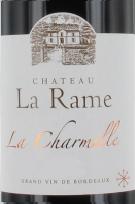 Cadillac, an appellation best known for sweet wines, also produces a small amount of red, including this one that consumers should flock to. To remind consumers the wines come from Bordeaux, the Cadillac appellation along with three neighboring ones, Blaye, Francs, and Castillon, have joined forces, lobbied for and won approval of, an umbrella appellation now known as Côtes de Bordeaux. A blend of two-thirds Merlot and Cabernet Sauvignon, a “not just fruit” character harmonizes with the plump, but not over ripe, black fruit you’d expect from the exceptional 2009 vintage. This is not a “fruit bomb,” but rather a wonderful expression of Bordeaux at an equally appealing price. Supple tannins lend structure, but since they don’t intrude, it’s a pleasure to drink it now.
Cadillac, an appellation best known for sweet wines, also produces a small amount of red, including this one that consumers should flock to. To remind consumers the wines come from Bordeaux, the Cadillac appellation along with three neighboring ones, Blaye, Francs, and Castillon, have joined forces, lobbied for and won approval of, an umbrella appellation now known as Côtes de Bordeaux. A blend of two-thirds Merlot and Cabernet Sauvignon, a “not just fruit” character harmonizes with the plump, but not over ripe, black fruit you’d expect from the exceptional 2009 vintage. This is not a “fruit bomb,” but rather a wonderful expression of Bordeaux at an equally appealing price. Supple tannins lend structure, but since they don’t intrude, it’s a pleasure to drink it now.
91 Michael Apstein Apr 23, 2013
Château Moulin Pey-Labrie, Canon-Fronsac (Bordeaux, France) 2000 ($30, Louis Dressner Selections): Wines from the ‘lesser’ or more obscure appellations within Bordeaux offer great value, especially from stellar vintages, such as 2000. Canon-Fronsac is a small area adjacent to St. Emilion where Merlot predominates. In 2000, Château Moulin Pey-Labrie made a big, succulent wine that retains the charm and structure of Bordeaux that is just starting to show the nuances of maturity. 90 Michael Apstein Nov 14, 2006
Château Guerry, Côtes de Bourg (Bordeaux, France) 2003 ($27, Cape Cod Wholesale Wine & Spirits): Côtes de Bourg, a small, less well-known appellation across the Gironde Estuary from the Médoc, can be a place to find values in Bordeaux when the quality of the winemaking exceeds the prestige of the appellation. Such is the case with the 2003 Château Guerry. From the engaging bouquet, you immediately sense this wine will deliver enjoyment. The balance of fruit and mineral flavors coupled with its length confirms that first impression. 90 Michael Apstein Nov 14, 2006
Château Barrié, Côtes de Bourg (Bordeaux, France) 2005 ($12, ExCellars): The less prestigious red wines from the great 2005 vintage in Bordeaux are just starting to arrive on our shores. They should not be missed. The beauty of this vintage is the quality of the wines at all price levels, especially from less well-known areas. The Côtes de Bourg is one of those small, relatively obscure areas across the Gironde estuary from the more famous Médoc. It produces a bevy of well-priced wines. The ripe plumy forward fruit character is reminiscent of the best in California, but its moderate weight and elegance (the signature of Bordeaux) suggests France as its source. A forward style of Bordeaux, it will have great appeal to both New and Old World palates. 88 Michael Apstein Feb 13, 2007
Château Sauman, Côtes de Bourg (Bordeaux, France) 2005 ($11, ExCellars): Perhaps even slightly more polished and silky than the Château Barrié also reviewed here, this shows its higher percentage of Merlot in the blend. The wine has a seductive, smoky, earthy element to it that lends added interest. 88 Michael Apstein Feb 13, 2007
Château Cantemerle, Haut-Medoc (Bordeaux) 2008 ($44): The 2008 Bordeaux will always be lost in the shadows of the 2009 and 2010s, but they still demand serious consideration because of their classic proportions. Château Cantemerle has made a beautiful wine infused with notes of cedar intertwined with red and black fruit surrounded by sweet suave tannins. This is very Bordeaux–not aggressive or overblown. It’s remarkably easy to drink at this stage, but I suspect it will close up over the next several years before the complexity reemerges in a decade or so. So enjoy it now–or be prepared to cellar it.
90 Michael Apstein Feb 12, 2013
Château Cantemerle, Haut-Médoc (Bordeaux, France) 2010 ($49): 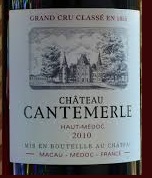 Château Cantemerle, a property included as a 5th growth in the famed 1855 Médoc Classification, is always a great value. In a stellar year, such as 2010, it’s even a better buy. The vineyard is planted to Cabernet Sauvignon (50%), Merlot (40%) with the remaining acreage divided evenly between Cabernet Franc and Petit Verdot. Since the blend usually reflects what’s planted, the fleshiness of the 2010 may represent the high proportion of Merlot and Petit Verdot. A vivid freshness, a welcome characteristic of the 2010 vintage, balances its lush ripeness. With time in the glass, a haunting, dense minerality appears in this suave, beautifully textured wine. Easy to enjoy now, it will, like many grand Bordeaux, “close up” in the next couple of years, so pop the cork soon or plan to cellar it for a decade.
Château Cantemerle, a property included as a 5th growth in the famed 1855 Médoc Classification, is always a great value. In a stellar year, such as 2010, it’s even a better buy. The vineyard is planted to Cabernet Sauvignon (50%), Merlot (40%) with the remaining acreage divided evenly between Cabernet Franc and Petit Verdot. Since the blend usually reflects what’s planted, the fleshiness of the 2010 may represent the high proportion of Merlot and Petit Verdot. A vivid freshness, a welcome characteristic of the 2010 vintage, balances its lush ripeness. With time in the glass, a haunting, dense minerality appears in this suave, beautifully textured wine. Easy to enjoy now, it will, like many grand Bordeaux, “close up” in the next couple of years, so pop the cork soon or plan to cellar it for a decade.
92 Michael Apstein Sep 17, 2013
Barons de Rothschild, Haut-Médoc (Bordeaux, France) “Edmond Benjamin” 2003 ($30, Royal Wine Company): Beautifully balanced, this wine shows the class of well-made Bordeaux. It’s plush (40% Merlot speaking) but retains structure (60% Cabernet Sauvignon) without hardness. A hint of earthiness adds intrigue. They have resisted the temptation to overwork and over-extract this wine from a modest, not grand, appellation. It’s a difficult balance to achieve, especially at this price level. The result is an extraordinarily enjoyable wine for current consumption. By the way, it’s Kosher. 91 Michael Apstein Sep 4, 2007
Château Coufran, Haut-Médoc (Bordeaux, France) 2010 ($24): Château Coufran, though not included in the rarefied Médoc Classification of 1855, consistently makes splendid wines and sells them at reasonable prices. Their lush, approachable wines are a good place to start for those interested in learning about Bordeaux. For us Bordeaux lovers, seeing Château Coufran on a wine list is a welcome sight. Château Coufran’s focus on Merlot, more than 75 percent of the blend, is unusual for the Médoc and helps explain its popularity. Though plush, the 2010 Coufran has plenty of structure and enlivening freshness. Drink over the next couple of years with a steak or cellar it for a decade. From my experience with Coufran, they wines from top vintages, such as 2010, develop marvelously.
90 Michael Apstein Sep 24, 2013
Barons Edmond & Benjamin de Rothschild, Haut-Médoc (Bordeaux, France) 2005 ($35): This typical Bordeaux blend–Cabernet Sauvignon, 60%, and the remainder Merlot–from a great vintage delivers an engaging combination of tobacco, herbs, black currant fruit. With slightly sticky tannins, unusual for the 2005 vintage, this is a serious, food-oriented wine, ideal for leg of lamb or beef stew. It’s another good wine that happens to be kosher, but which is worth recommending even if it weren’t. 87 Michael Apstein Oct 7, 2008
Château de Bel-Air, Lalande de Pomerol (Bordeaux, France) 2006 ($24, Canon Wines): Across a tiny stream from Pomerol is Lalande de Pomerol, an appellation that uses the same blend of grapes–predominately Merlot and Cabernet Franc–to produce wines styled similarly to those of its more famous neighbor. The 2006 Château de Bel-Air conveys an intriguing ‘not just fruit’ quality of attractive earthy and gamey elements to balance its ripe black fruit flavors. Firm, but fine, tannins lend support and backbone to this well-balanced wine. This is no light-weight Bordeaux for current drinking, but is more suited for five or so years in the cellar. 90 Michael Apstein May 5, 2009
Château Sergant, Lalande de Pomerol (Bordeaux, France) 2009 ($37, Vintus): Château Sergant is another fine estate under the Milhade umbrella. 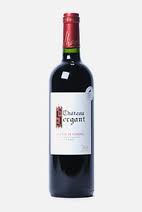 Slightly bigger and more robust than Château Tour D’Auron (also reviewed this week), it maintains the signature Milhade class. Befitting a more prestigious appellation, it has more going on and even some engaging gamey elements. It’s very easy to recommend for current consumption. 90 Michael Apstein Apr 24, 2012
Slightly bigger and more robust than Château Tour D’Auron (also reviewed this week), it maintains the signature Milhade class. Befitting a more prestigious appellation, it has more going on and even some engaging gamey elements. It’s very easy to recommend for current consumption. 90 Michael Apstein Apr 24, 2012
Chateau Brane-Cantenac, Margaux (Bordeaux, France) 2005 ($110, Diageo Chateau and Estate Wines):
Normally, Brane-Cantenac puts only about one-third of its total production into its first wine–the grand vin–with the remainder going into a second and third label. But 2005 was such a phenomenal year that about half their production made the cut. As good as their 2004 is (also reviewed this week), the 2005 is even better. The tannins are silkier, the core of black fruit spiced with earthy flavors is deeper, and the whole package glossier and longer. Still tightly wound, give it a decade at least in the cellar to allow all its glories to unfold.
95 Michael Apstein Feb 3, 2009
Château d’Issan, Margaux (Bordeaux, France) 2005 ($75, Diageo Chateau & Estate): Since Emmanuel Cruz took charge of this estate in 1998, the quality has taken a giant step forward. The 2005 Château d’Issan reminds me of one of the great wines from Margaux from the past, with its mineral-like qualities atop the quintessential Margaux velvetiness. The supple, fine-grained tannins and bright acidity lend structure to the wine’s lush, ripe, black fruit-like qualities. Hard to resist now, it will evolve beautifully over the next two decades and reward those who opt to cellar this gem. 95 Michael Apstein May 6, 2008
Château Marquis de Terme, Margaux (Bordeaux, France) 2010 ($53): Given the current world wide demand and stratospheric prices of the classified growths from Bordeaux, it’s not surprising not all but the super rich overlook this category of wine. But that would be a mistake because there remain properties overcoming lousy reputations whose prices have yet to catch with their newly found quality. Château Marquis de Terme, classified as a fourth growth in the Médoc Classification of 1855, is one such property. The owners brought on a new winemaker and estate manager, Ludovic David, in 2009 with the intention of raising the quality of the wine. He’s done just that. The 2010 is perfectly stunning and dramatically underpriced in today’s Bordeaux market. The 2010 has the dark mineral-like density of great Margaux coupled with the suave texture characteristic of that appellation. Great length and a floral component just add allure. An amazing freshness and vivacity keeps you coming back for more.
95 Michael Apstein Apr 23, 2013
Château Rauzan-Ségla, Margaux (Bordeaux, France) 1999 ($40): The commune of Margaux, unlike the rest of the Médoc, made exceptional wine in 1999, much like 1983. The prices remain reasonable because the entire vintage is forgotten next to the glorious 2000s. Château Rauzan-Ségla continues to improve at a rate far faster than its prices rise. Their 1999 is still widely available at the retail level and should be snatched up whenever you see it. Ripe and silky, it has layers of earthiness intermingled with black fruit. Hard to resist now, it should develop beautifully over the next decade. 94 Michael Apstein Feb 28, 2006
Château Rauzan-Ségla, Margaux (Bordeaux, France) 2008 ($78): Rauzan-Ségla is a great success in 2008. It combines the silkiness characteristic of the wines from the commune of Margaux with a dark core of mineral-infused fruitiness. It’s conveys power without being “in-your-face.” Nuances of tobacco and cedar emerge as the wine sits in the glass. Long and polished, it will be even better with a decade of cellaring. 94 Michael Apstein Feb 7, 2012
Château D’Issan, Margaux (Bordeaux, France) 2008 ($59): The 2008 vintage in Bordeaux is destined to always be overshadowed by the much praised—and more expensive—2009 vintage, which means there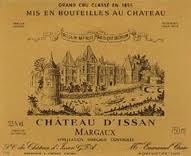 are some excellent, well-priced wines, like this one, to be found among the 2008s. Showing its Margaux origins, the 2008 D’Issan is plush and velvety with polished tannins wrapped around a deep mineraly core. Not a bombastic wine, it still has plenty of concentration and power. Yet, its elegance, balance and length are what’s captivating. Appropriately youthful and tightly wound at this stage, it’s best left in the cellar for a decade. 93 Michael Apstein Jan 31, 2012
are some excellent, well-priced wines, like this one, to be found among the 2008s. Showing its Margaux origins, the 2008 D’Issan is plush and velvety with polished tannins wrapped around a deep mineraly core. Not a bombastic wine, it still has plenty of concentration and power. Yet, its elegance, balance and length are what’s captivating. Appropriately youthful and tightly wound at this stage, it’s best left in the cellar for a decade. 93 Michael Apstein Jan 31, 2012
Château D’Issan, Margaux (Bordeaux, France) 2008 ($59): The 2008 vintage in Bordeaux is destined to always be overshadowed by the much praised–and more expensive–2009 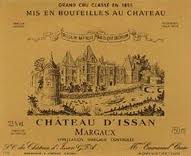 vintage, which means there are some excellent, well-priced wines, like this one, to be found among the 2008s. Showing its Margaux origins, the 2008 D’Issan is plush and velvety with polished tannins wrapped around a deep mineraly core. Not a bombastic wine, it still has plenty of concentration and power. Yet, its elegance, balance and length are what’s captivating. Appropriately youthful and tightly wound at this stage, it’s best left in the cellar for a decade. 93 Michael Apstein Feb 1, 2012
vintage, which means there are some excellent, well-priced wines, like this one, to be found among the 2008s. Showing its Margaux origins, the 2008 D’Issan is plush and velvety with polished tannins wrapped around a deep mineraly core. Not a bombastic wine, it still has plenty of concentration and power. Yet, its elegance, balance and length are what’s captivating. Appropriately youthful and tightly wound at this stage, it’s best left in the cellar for a decade. 93 Michael Apstein Feb 1, 2012
Château Marquis de Terme, Margaux (Bordeaux, France) 2009 ($52): The much-heralded 2009 vintage in Bordeaux produced ripe and rich wines because of virtually perfect weather throughout the growing season. They are a great contrast to the more racy and structured 2010s. Both are considered equally great vintages. Your preference will likely depend on whether you prefer riper and fleshier wines (2009) or tauter ones (2010). Château Marquis de Terme brought in a new team in 2009 and the improvement in the wines is immediately apparent. The new winemaker, Ludovic David, is an advocate of a later harvest to enhance ripeness and eliminate vegetal notes. The 2009 is rich, ripe and dense, yet retains brilliant acidity and freshness that David attributes to the “acidic terroir” and inclusion of a dollop of Petit Verdot, a grape known for its acidity. The plushness of Margaux in evident in this gorgeous young wine and indeed, allows those without a cellar to enjoy it now for its exuberance. Like their 2010, the 2009 Marquis de Terme is an excellent buy in today’s market.
93 Michael Apstein Apr 23, 2013
Chateau Brane-Cantenac, Margaux (Bordeaux, France) 2004 ($55, Diageo Chateau and Estate Wines): Brane-Cantenac, a second growth Bordeaux located in the commune of Margaux, has been on a roll lately, making excellent wines in 2003, 2004 and 2005. The only thing wrong with the 2004 red Bordeaux overall is that they will always be in the shadow of the stupendous 2005s. But for now, the 2004 Brane-Cantenac–a wonderful wine–is more enjoyable to drink than the more widely coveted 2005. A deep core of black fruit and earthy nuances enrobed in silky tannins make it a textbook Margaux. For a young Bordeaux it has remarkable development that helps explain why it’s easy–and satisfying–to drink now. Half the price of the 2005 Brane-Cantenac, it’s an excellent choice for dinner tonight. 92 Michael Apstein Feb 3, 2009
Baron de Brane, Margaux (Bordeaux, France) 2007 ($35): Baron de Brane is the second wine of Chateau Brane Cantenac, a Bordeaux property given 2nd growth status in the Medoc Classification of 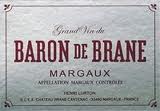 1855. Second wines, like this one, are made from batches the winemaking team deemed not suitable for the grand vin. The wine could have come from young vines or lacked the structure and density the winemaker was seeking. Typically earlier maturing, they are a great bargain for the consumer because you get a sense of the character and style of the property at a far lower price. This is a great example. Don’t be put off by the vintage. Conscientious producers, like Brane Cantenac, make good wine even in less exalted years. This 2007 Baron de Brane is ready to drink now with plush tannins — it does come from Margaux–and cassis-laden fruitiness. It has surprising complexity for a second wine and is perfect with a steak now. 90 Michael Apstein Dec 4, 2012
1855. Second wines, like this one, are made from batches the winemaking team deemed not suitable for the grand vin. The wine could have come from young vines or lacked the structure and density the winemaker was seeking. Typically earlier maturing, they are a great bargain for the consumer because you get a sense of the character and style of the property at a far lower price. This is a great example. Don’t be put off by the vintage. Conscientious producers, like Brane Cantenac, make good wine even in less exalted years. This 2007 Baron de Brane is ready to drink now with plush tannins — it does come from Margaux–and cassis-laden fruitiness. It has surprising complexity for a second wine and is perfect with a steak now. 90 Michael Apstein Dec 4, 2012
Blason D’Issan, Margaux (Bordeaux, France) 2008 ($37): Can’t wait a decade to drink the 2008 Château D’Issan (also reviewed this week)? Try D’Issan’s second wine, Blason D’Issan. Emmanuel Cruse, whose family owns Château D’Issan, says that the difference between their Grand Vin (Château D’Issan) and Blason is chiefly the age of the vines. For Blason, the vines average 18 years of age and roughly twice that for the first wine. The two are vinified the same way, with the Grand Vin receiving a touch more aging in oak barrels than Blason. In the past, second wines have been relegated to supermarkets of France, but now to export them, they must focus on higher quality. And it shows. While the Blason lacks the complexity of its big brother, it still delivers the plushness and mineraly character of Margaux. The plus side is that the 2008 Blason is more approachable now and would be a good choice with a steak tonight. 90 Michael Apstein Jan 31, 2012
Chateau Brane-Cantenac, Margaux (Bordeaux, France) 2003 ($60, Diageo Chateau and Estate Wines): The quality of Brane-Cantenac’s 2003, a difficult year to make wine because of extreme heat, demonstrates the talent of the team Henri Lurton has in place. It’s a refined wine, showing the plush tannins characteristic of wines from the commune of Margaux, without a trace of the baked or pruney quality that marred many wines from that vintage. It has a lovely combination of dark fruit, wet earth and spice. Still unevolved, it would benefit from several more years of cellaring. Its lovely balance and grace at this stage virtually guarantees that it will continue to evolve nicely. 90 Michael Apstein Feb 3, 2009
Château d’Issan, Margaux (Bordeaux, France) 2007 ($50): The 2007 vintage in Bordeaux has been lost between 2006 and 2008, two more successful ones. But it’s important for consumers to remember that dedicated producers, such as Chateau d’Issan, still make excellent wines in these “lesser” years. The quality of the wines of d’Issan has sky-rocketed since Emmanuel Cruse took the reigns in 1998. One technique that allows producers to turn out memorable wines in less than memorable years is to make a more rigorous selection. In 2007, a whopping 60% of d’Issan production went into their second wine, Blason d’Issan. As a result, the 2007 Chateau d’Issan is a brilliant wine with real class. Ripe without being weighty or heavy, it conveys the earthy mineraly often lacking in lesser wine from Margaux. Atypical for Cru Classé Bordeaux, it’s remarkably enjoyable now. 90 Michael Apstein Mar 8, 2011
Labastide Dauzac, Margaux (Bordeaux, France) 2007 ($41, W. J. Deutsch & Sons Ltd.): The so-called “second” wines of Bordeaux chateaux, such as this one from Chateau Dauzac, offer the consumer great value. Typically they are made from the property’s younger vines or batches that for some reason don’t make the cut to be included with the flagship Grand Vin. This one, a blend of Merlot (60%) and Cabernet Sauvignon, has all the suaveness and silkiness you’d expect from Margaux. Already delivering lovely cedar and tobacco notes to complement a mixture of red and black fruit notes, it’s remarkably enjoyable now. Good concentration and length completes the package, making it a good choice if you need a classy wine for tonight’s dinner. 89 Michael Apstein Jan 24, 2012
Baron de Brane, Margaux (Bordeaux, France) 2003 ($40, Diageo Chateau and Estate Wines): Baron de Brane is the second wine of Chateau Brane-Cantenac. Second wines are usually made from younger vines or portions of the vineyard that are less ideally situated. They typically lack the elegance and finesse of le grand vin; they’re not necessarily lighter. The 2003 Baron de Brane explains why the 2003 Brane Cantenac is so good. All of the less refined elements are in the Baron, giving this wine a charming rusticity to accompany its considerable concentration. The tannins, while slightly coarser, are still not astringent or intrusive. Nicely evolved with alluring mature elements showing to offset the dark fruit, it would be a good choice for hearty winter fare now. 88 Michael Apstein Feb 3, 2009
Château des Granges d’Or, Médoc (Bordeaux, France) 2005 ($14, ExCellars):
Although the most famous 2005 Cru Classé wines from the Médoc are frightfully expensive, the Cru Bourgeois (the next level 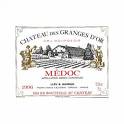 down in classification) are not, and many, such as this one, are classy and refined. This bottling shows the class of the Médoc, one the best areas in Bordeaux for red wine. With more tannin and structure at this stage than the 2005 Château Barrié or Château Sauman–two wines from the Côtes de Bourg I recommend highly–it needs a few years to soften and come together. But I am certain it will because it has plenty of sweet fruit and non-fruit flavors to balance the tannins. Ultimately it will be a better wine than those two from the Côtes de Bourg, but give it time. This is an ideal purchase for either a new or established wine cellar with an eye towards consumption in 5 years. Just be sure to buy enough of two wines from the Côtes de Bourg to drink while you’re waiting for this one to become ready.
down in classification) are not, and many, such as this one, are classy and refined. This bottling shows the class of the Médoc, one the best areas in Bordeaux for red wine. With more tannin and structure at this stage than the 2005 Château Barrié or Château Sauman–two wines from the Côtes de Bourg I recommend highly–it needs a few years to soften and come together. But I am certain it will because it has plenty of sweet fruit and non-fruit flavors to balance the tannins. Ultimately it will be a better wine than those two from the Côtes de Bourg, but give it time. This is an ideal purchase for either a new or established wine cellar with an eye towards consumption in 5 years. Just be sure to buy enough of two wines from the Côtes de Bourg to drink while you’re waiting for this one to become ready.
90 Michael Apstein Feb 13, 2007
Château Tour Blanche, Médoc (Bordeaux, France) 2003 ($30, Cape Cod Wholesale Wine & Spirits): This château, classified as a Cru Bourgeois, just one level beneath the Cru Classé, produced a succulent lovely wine in 2003. Despite its ripe flavors, as expected from that very warm year in Bordeaux, and remarkable suppleness, it’s still readily identifiable as coming from the Médoc. 90 Michael Apstein Nov 14, 2006
Château Loudenne, Médoc (Bordeaux, France) 2004 ($25, Maisons Marques and Domaines): This blend of Cabernet Sauvignon and Merlot shows why the red wines from Bordeaux continue to be popular. This Cru Bourgeois (one level down from the far more prestigious–and expensive–Cru Classé) delivers nice ripeness intertwined with herbal, almost leafy, elements and buttressed by firm, but not astringent or intrusive, tannins. The 2004 vintage will always live in the shadow of the superb 2005, but that also means that prices for it will be more reasonable. 87 Michael Apstein Sep 16, 2008
Château de Parsac, Montagne St. Émilion (Bordeaux, France) 2007 ($35, Royal Wine Company): Montagne St. Emilion, one of what are known as ‘satellite’ appellations of St. Emilion, is a good place to find St. Emilion-styled wines at non-St. Emilion prices. Like wines from St. Emilion, this blend, primarily Merlot (80%) and Cabernet Sauvignon, offers a more savory–almost leafy–expression of Merlot compared to its California counterpart. Fine, polished tannins lend support without astringency and mean you can enjoy it without further aging. Kosher for Passover, I would be delighted to find it on a seder table this year. 88 Michael Apstein Mar 10, 2009
Chateau Pichon Lalande, Pauillac (Bordeaux, France) 2003 ($150, Maisons, Marques and Domaines): The heat and drought in France in 2003 resulted in unusual wines–both splendid and abysmal. Put this one in the former category. 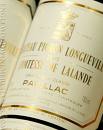 Incredibly elegant and layered, the 2003 Pichon Lalande is beautifully balanced and neither overdone nor over extracted. The earthy black current flavors glide over your palate. You feel the effect of oak aging without tasting the wood. Perfectly ripe fruit and well-honed tannins add a gorgeous suppleness. Tasting it side-by-side with Reserve de la Comtesse, Pichon Lalande’s second wine, you immediately appreciate its refinement and length, not just its power. 95 Michael Apstein Jun 24, 2008
Incredibly elegant and layered, the 2003 Pichon Lalande is beautifully balanced and neither overdone nor over extracted. The earthy black current flavors glide over your palate. You feel the effect of oak aging without tasting the wood. Perfectly ripe fruit and well-honed tannins add a gorgeous suppleness. Tasting it side-by-side with Reserve de la Comtesse, Pichon Lalande’s second wine, you immediately appreciate its refinement and length, not just its power. 95 Michael Apstein Jun 24, 2008
Reserve de la Comtesse, Pauillac (Bordeaux, France) 2003 ($50, Maisons, Marques and Domaines): A ‘super second’ in Bordeaux refers to the handful of chateaux classified as a second growth in the Médoc Classification of 1855 but which command higher prices than others similarly classified. However, the same term is appropriate for this wine, the second wine from Chateau Pichon Lalande, one of the ‘super seconds.’ Even though a slice of Pichon Lalande’s vineyards is in the neighboring commune of St. Julien, this wine is a classically structured Pauillac with a vaguely tarry minerality intermixed with black currant fruit flavors that is characteristic of the wines from that commune. It’s beautifully balanced Bordeaux from a year that produced some awkward wines. And at a third the price of the first wine (also reviewed this week), it’s a bargain. 90 Michael Apstein Jun 24, 2008
Domaine de Chevalier, Pessac-Léognan (Bordeaux, France) Rouge 2009 ($80): A criticism of the 2009 Bordeaux vintage is that the ripeness and power obliterate the origin and typicity of the wines. That may be true for some, but not for Domaine de Chevalier, who, as usual, made a gorgeous wine. Ripe and lush flavors intermingle seamlessly with earthy and dusty notes, maintaining the alluring ash-like signature of Pessac-Léognan. The tannins are plush and polish. Extraordinarily long, the wow-factor is the seemingly endless array of flavors, not just its power. It’s classy and elegant and given the price of many of the ‘09 Bordeaux, a relative bargain. 97 Michael Apstein Mar 6, 2012
Château Couhins-Lurton, Pessac-Léognan (Bordeaux, France) Rouge 2002 ($32, Classic Wine Imports; WJ Deutsch & Sons): In 1970, André Lurton purchased Château Couhins, a cru classé property in Pessac-Léognan. He has upgraded the property and extended it to include vineyards with Merlot and Cabernet Sauvignon, varieties that had been planted there in the 14th century. The 2002, only the third vintage of the red wine, is marvelous. A blend of roughly 75% Merlot and the remainder Cabernet Sauvignon, it has gamy and exotic flavors wrapped around a core of fruit. It’s engaging now thanks to its supple tannins, beautiful balance and long finish, but its structure suggests it will evolve nicely over the next decade. 93 Michael Apstein Sep 26, 2006
Château Hosanna, Pomerol (Bordeaux, France) 2003 ($200, Maisons, Marques and Domaines): In 1999, Christian Moueix purchased a well-established vineyard, formerly called Château Certan Giraud, adjacent to Chateau Pétrus, upgraded it by selling off a less desirable piece, and renamed it Chateau Hosanna. Planted with roughly 2/3rds Merlot and 1/3 Cabernet Franc, Moueix believes it is a more ‘feminine’ and approachable wine compared to the almost 100% Merlot Pétrus. Moueix attributes part of the success of all their properties in 2003, a notoriously hot year, to not trimming the vine canopies, but letting them grow and shade the grapes. That technique paid off with this wine, the class and polish of which is readily apparent. Not jammy or over-extracted, it is just ripe, rich and long, filled with dark fruit and earth flavors. Although enjoyable now–the tannins are fine and supple–it should evolve nicely over the next decade. 94 Michael Apstein Jun 24, 2008
Château Pérenne, Premières Côtes de Blaye (Bordeaux, France) 2004 ($30, Cape Cod Wholesale Wine & Spirits): A lesser-known appellation adjacent to Côtes de Bourg on the Right Bank, the Premières Côtes de Blaye is a name to remember when looking for ‘value’ in Bordeaux. Château Pérenne, made from a blend of about 75% Merlot and 25% Cabernet Sauvignon and classified as a Cru Bourgeois, is one of the 23 properties Bernard Magrez owns in Bordeaux. Magrez is committed to making unique and distinctive wines whether the grapes come from his flagship vineyard, Château Pape Clément, or a less renowned vineyard, such as this one. Aromatic and long, its ripe flavors wrapped in supple tannins makes it exceedingly enjoyable even now. 90 Michael Apstein Nov 14, 2006
Chateau Boutisse, Saint-Emilion Grand Cru (Bordeaux, France) 2009 ($36): Château Boutisse shows why St. Emilion has such a terrific reputation. Ripe fruit flavors are apparent, but not overdone. Most importantly, intriguing herbal notes balance the wine and add complexity. Overall, it’s graceful and long. The lushness of the 2009 vintage and resulting smooth ripe tannins makes it easy to enjoy now, especially with a steak. My experience with the wines from the Milhade stable, such as Château Boutisse, is that they develop beautifully with age. So don’t drink it all now.
91 Michael Apstein May 1, 2012
Château Magdelaine, St. Emilion (Bordeaux, France) 2004 ($100, Maison Marques and Domaines):  Christian Moueix has been upgrading this property that his father purchased in 1952. Planted with a very high proportion of Merlot 90% with the remainder Cabernet Franc, the 2004 is quite forward and approachable now with supple tannins and alluring leafy/earthy elements mixed with nicely proportioned red fruit flavors. It’s a classic style–not a ‘new wave’–St. Emilion that I suspect will close down in a year or two and then emerge with even more complexity in a decade. My advice is to drink it now or be prepared to wait. 92 Michael Apstein Jun 24, 2008
Christian Moueix has been upgrading this property that his father purchased in 1952. Planted with a very high proportion of Merlot 90% with the remainder Cabernet Franc, the 2004 is quite forward and approachable now with supple tannins and alluring leafy/earthy elements mixed with nicely proportioned red fruit flavors. It’s a classic style–not a ‘new wave’–St. Emilion that I suspect will close down in a year or two and then emerge with even more complexity in a decade. My advice is to drink it now or be prepared to wait. 92 Michael Apstein Jun 24, 2008
Château Boutisse, St. Émilion (Bordeaux, France) 2005 ($37, Ex Cellars Wine Agency):
There is probably more variation in quality in St. Émilion than in any other similarly sized appellation in Bordeaux, which makes buying them without knowing the specific property dicey. You can buy the 2005 Château Boutisse without hesitation. Earthy, plush and quite long, it reflects the stature of the appellation and underscores why wines from this village are so popular. It has great aromatics and succulent fruit mingled with a hint of chocolate. The fines silky tannins allow you to enjoy it now, but cellaring it for several years will bring additional pleasure.
92 Michael Apstein Oct 23, 2007
Château Corbin, St. Emilion Grand Cru (Bordeaux, France) 2005 ($45, David Milligan Selections): Château Corbin lies on the border of Pomerol and St. Emilion with one of its vineyards bordering those of Château Bon Pasteur. As with most right bank wines, it is a blend of Merlot (80%) and Cabernet Franc (20%). The lushness and ripe tannins characteristic of the Merlot in 2005 give it finesse and elegance while the earthy flavors and backbone come from ripe Cabernet Franc. The combination of deep red fruit flavors coupled with leafy earthiness and polished tannins makes it easy to recommend. 90 Michael Apstein Apr 29, 2008
Château de Pez, St. Estèphe (Bordeaux, France) 2005 ($43, Maisons Marques and Domaines): 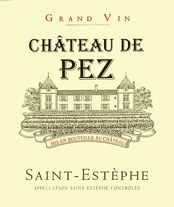 The beauty of the 2005 vintage in Bordeaux shows in this wine. There’s the quintessential gritty earthiness of St. Estèphe, but with a polish and suppleness that is unusual for a young wine from that appellation. Gorgeous aromas pour from the glass and are followed by an equally attractive combination of black fruit, spice and earth that persist into a long finish. A beauty now with a steak or other grilled meat, it should evolve and develop wonderfully over the next decade. Here’s betting few will wait. 92 Michael Apstein Jan 18, 2011
The beauty of the 2005 vintage in Bordeaux shows in this wine. There’s the quintessential gritty earthiness of St. Estèphe, but with a polish and suppleness that is unusual for a young wine from that appellation. Gorgeous aromas pour from the glass and are followed by an equally attractive combination of black fruit, spice and earth that persist into a long finish. A beauty now with a steak or other grilled meat, it should evolve and develop wonderfully over the next decade. Here’s betting few will wait. 92 Michael Apstein Jan 18, 2011
Château Haut-Beausejour, St. Estèphe (Bordeaux, France) 2005 ($30, Maisons, Marques and Domaines): For those searching for bargains among the sensational 2005 vintage in Bordeaux, reach for Château Haut-Beausejour. Wonderfully ripe, it has a plushness that is unusual for St. Estèphe, whose wines frequently come across as much tougher. An exotic, herbal nose carries through onto the palate and balances the rich black fruit flavors. Very expressive at this stage, it’s hard to resist, although it has the requisite balance and structure to age effortlessly for more than a decade. 90 Michael Apstein Jun 24, 2008
Château de Pez, St. Estèphe (Bordeaux, France) 2005 ($45, Maisons Marques and Domaines): This property, classified as a Cru Bourgeois, continues to produce distinctive wines. Characteristic of the 2005 vintage in Bordeaux, this wine offers succulent ripeness without obliterating the underlying firm and slightly dusty character of St. Estèphe. Add that to the suaveness and length expected from the vintage, and you have an attractively-priced winner for your cellar. 89 Michael Apstein Jul 1, 2008
Château de Pez, St. Estèphe (Bordeaux, France) 2003 ($36, Maisons Marques and Domaines): Many of the red wines from the initially much-heralded 2003 vintage are maturing quite rapidly and this vintage may not turn out to live up to the potential many ascribed to it. The silver lining is that wines that normally need a decade to unfold are showing mature flavors already. Château de Pez (always deserving of its Cru Bourgeois classification) delivers dried fruit notes atop earthy nuances. The wine is nicely balanced with none of the sense of over extraction that plagued some wines from this vintage. The tannins lend support and there’s enough acidity to keep it fresh. 88 Michael Apstein Sep 16, 2008
Château Haut-Beauséjour, St. Estèphe (Bordeaux, France) 2004 ($27, Maisons Marques and Domaines): The 2004 vintage in Bordeaux will always be overlooked, overshadowed by the 2005s. In a way, that represents an opportunity for consumers because the vintage produced some excellent wines. Haut-Beauséjour, like its stablemate, Chateau de Pez, manages to deliver wines that are remarkably ripe without eliminating the underlying characteristics of the specific appellation. Its combination of suaveness, earthy black currant nuances and herbal notes make it attractive for current drinking. 88 Michael Apstein Jul 1, 2008
Cos d’Estournel, St. Estèphe (Bordeaux, France) 2004 ($100, Maisons, Marques and Domaines): Overall, this is a ripe and well-balanced wine true to its St. Estèphe origins. With layers of underlying flavors–meaty, smoky and black fruit–it has ample stuffing to hold up against the fine-grained but abundant tannins. It’s a good candidate for a decade in the cellar. 88 Michael Apstein Jun 24, 2008
Cos d’Estournel, St. Estèphe (Bordeaux, France) 2003 ($250, Maisons Marques and Domaines):  Reflective of the heat and drought of 2003, this wine exhibits very ripe, almost jammy or stewed fruit character. The enormous tannins are dense–but not astringent–and make the wine almost impenetrable at this stage. This is an atypical Cos d’Estournel, the concentration and size of which overshadows the usual dusty, spicy, earthy character of St. Estephe. 87.
Reflective of the heat and drought of 2003, this wine exhibits very ripe, almost jammy or stewed fruit character. The enormous tannins are dense–but not astringent–and make the wine almost impenetrable at this stage. This is an atypical Cos d’Estournel, the concentration and size of which overshadows the usual dusty, spicy, earthy character of St. Estephe. 87.
87 Michael Apstein Jul 29, 2008
Pagodes de Cos, St. Estèphe (Bordeaux, France) 2004 ($42, Maisons Marques and Domaines): Second wines from the classified Bordeaux chateaux are becoming  increasingly popular as the prices of the first wines continue to rise. Often they are good buys, especially in the great vintages, such as 2005, and ready to drink sooner than the chateau’s first wine. Although the Pagodes, the second wine of Cos d’Estournel, is attractively priced for a wine from a classified chateau, the dusty, drying tannins typical of wines from St. Estephe overwhelm the black currant-like fruit flavors at this stage and suggest that several more years are necessary before it becomes accessible. 85 Michael Apstein Jul 22, 2008
increasingly popular as the prices of the first wines continue to rise. Often they are good buys, especially in the great vintages, such as 2005, and ready to drink sooner than the chateau’s first wine. Although the Pagodes, the second wine of Cos d’Estournel, is attractively priced for a wine from a classified chateau, the dusty, drying tannins typical of wines from St. Estephe overwhelm the black currant-like fruit flavors at this stage and suggest that several more years are necessary before it becomes accessible. 85 Michael Apstein Jul 22, 2008
Château Lagrange, St. Julien (Bordeaux, France) 2005 ($75, Diageo Chateau & Estate):  One of the great aspects of the 2005 vintage in Bordeaux is that the wines reflect their origins; the Pauillacs taste like Pauillac and, as in this case, Château Lagrange shows its St. Julien pedigree. Lagrange’s blend in 2005–Cabernet Sauvignon (45%), Merlot (45%) and Petit Verdot (10%)–is a little unusual for St. Julien, whose wines typically rely more on Cabernet. Nonetheless, it coveys cedar and tobacco elements combined with cassis-like black fruit flavors and a hint of minerality characteristic of St. Julien. Its tannins are ripe and polished, which makes it easy to embrace now, but judging from my experience with Lagrange, it will develop even more complexity over the next 20 years. 95 Michael Apstein May 6, 2008
One of the great aspects of the 2005 vintage in Bordeaux is that the wines reflect their origins; the Pauillacs taste like Pauillac and, as in this case, Château Lagrange shows its St. Julien pedigree. Lagrange’s blend in 2005–Cabernet Sauvignon (45%), Merlot (45%) and Petit Verdot (10%)–is a little unusual for St. Julien, whose wines typically rely more on Cabernet. Nonetheless, it coveys cedar and tobacco elements combined with cassis-like black fruit flavors and a hint of minerality characteristic of St. Julien. Its tannins are ripe and polished, which makes it easy to embrace now, but judging from my experience with Lagrange, it will develop even more complexity over the next 20 years. 95 Michael Apstein May 6, 2008
Chateau Gruaud Larose, St. Julien (Bordeaux, France) 2003 ($60, Diageo): 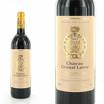 Great wines — such as the 2003 Gruaud Larose — have power, elegance and length. The layers of succulent black fruit flavors are matched by supple tannins. Delicious to taste now, it will be wonderful to drink in another decade or two. 94 Michael Apstein Nov 7, 2006
Great wines — such as the 2003 Gruaud Larose — have power, elegance and length. The layers of succulent black fruit flavors are matched by supple tannins. Delicious to taste now, it will be wonderful to drink in another decade or two. 94 Michael Apstein Nov 7, 2006
Château Gruaud Larose, St. Julien (Bordeaux) 2006 ($80): The 2006 vintage in Bordeaux, another one that risks being lost by its more praised predecessor, gives Bordeaux lovers a chance to buy at reasonable–at least by Cru Classé standards–prices. The vintage itself was excellent overall with some properties making better wines than in the more acclaimed 2005. The 2006 Gruaud Larose, a muscular wine with great power, also has exceptional polish. This Cabernet Sauvignon-based beauty has firm, but not aggressive tannins, and just a hint of tarry earthiness to complement its dark black-fruited profile. It’s starting to show a hint of maturity, and would be fine with a grilled steak tonight, but it will benefit from another decade of cellaring to show its real grandeur and complexity.
92 Michael Apstein Feb 12, 2013
Château Lagrange, St. Julien (Bordeaux, France) 2008 ($45): The 2008 vintage in Bordeaux, like 2001, is slipping under consumers’ radar screens as they anxiously await the far more hyped 2009s. That’s 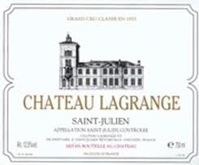 good news for those of us who like excellent wine and good wine prices. Château Lagrange has been on a roll since Marcel Ducasse was brought in to run it after Suntory, the Japanese drinks company, purchased it in 1983. Ducasse retired after the 2006 vintage, leaving Bruno Eynard, who had been the estate’s technical director for the previous 17 years, in charge. If anything, the wines have gotten even better under Eynard’s leadership. Despite, the highest percentage of Cabernet Sauvignon in the blend (72%) since the 2000 vintage, the 2008 is plush and graceful, with finely polished tannins. It delivers what has become the hallmark of Lagrange–an engaging combination of ripe sweet fruit and structure, with elegance and length. Ducasse, and now Eynard, have resisted the current trend to make big Bordeaux, opting to retain the grace and charm that St. Julien offers. Certainly enjoyable now, it will likely close down over the next year or two. So pop the cork now or plan to cellar it for a decade. You won’t be disappointed. 92 Michael Apstein Dec 27, 2011
good news for those of us who like excellent wine and good wine prices. Château Lagrange has been on a roll since Marcel Ducasse was brought in to run it after Suntory, the Japanese drinks company, purchased it in 1983. Ducasse retired after the 2006 vintage, leaving Bruno Eynard, who had been the estate’s technical director for the previous 17 years, in charge. If anything, the wines have gotten even better under Eynard’s leadership. Despite, the highest percentage of Cabernet Sauvignon in the blend (72%) since the 2000 vintage, the 2008 is plush and graceful, with finely polished tannins. It delivers what has become the hallmark of Lagrange–an engaging combination of ripe sweet fruit and structure, with elegance and length. Ducasse, and now Eynard, have resisted the current trend to make big Bordeaux, opting to retain the grace and charm that St. Julien offers. Certainly enjoyable now, it will likely close down over the next year or two. So pop the cork now or plan to cellar it for a decade. You won’t be disappointed. 92 Michael Apstein Dec 27, 2011
Les Fiefs de Lagrange, St. Julien (Bordeaux, France) 2008 ($23): Les Fiefs, the second wine of Château Lagrange, is a consistently great bargain. The 2008 is no exception. Always fruitier and more approachable than Lagrange itself, the family resemblance is apparent with its elegance and grace. Despite unusually high amount of Petit Verdot in the blend (14%), which lends an appealing concentration, the 2008 Les Fiefs still retains finesse of St. Julien and would not be confused with a New World fruit bomb. Lovely now, it too, like the grand vin, will likely close down in a year or two, so drink it now or cellar it for five years or so. The 2008 is a particularly good buy. 89 Michael Apstein Dec 27, 2011
Chateau Roc de Candale, St-Emilion Grand Cru (Bordeaux, France) 2004 ($36, Adler Fels Winery): The 2004 vintage in Bordeaux, despite its quality, is likely to be forever in the shadows of 2003 and 2005 and priced attractively. This engaging wine certainly is. Roc de Candale is the second label of Chateau Candale, which means that wine not suitable for the ‘grand vin’ ended up here. At first blush, you might be tempted to pass on wine that didn’t make the cut, but that would be a mistake because not only are second labels less expensive, but more importantly, they are ready to drink much sooner than the grand vin. This is a case in point. The 2004 Chateau Candale, still a baby, needs time for its tannic shell to mellow, whereas Roc de Candale, the second label, is glorious now. Made from 90 percent Merlot, it is lush and forward, but remarkably layered, with good structure. Earthy notes add intrigue and remind you that Merlot, when planted in the right spots, can make sumptuous wine 92 Michael Apstein Mar 27, 2007
Chateau de Sours, Bordeaux Rosé (France) 2012 ($16, Old Bridge Cellars): The vast amount of wine produced in Bordeaux is red. Another 20 percent or so is white, which leaves little room for rosé. But there is some, made from the usual red Bordeaux grapes. In this instance, a blend of Merlot (70%) and Cabernet Franc come together to produce a simple, yet rewarding, dry lightweight rosé, perfect for summer lunches or other light meals.
86 Michael Apstein Jul 9, 2013
Château Coutet, Barsac (Bordeaux, France) 2009 ($75): 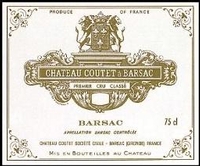 The wines from Barsac and Sauternes are undervalued compared to red Bordeaux because drinking these sweet wines at the end of a meal with, or better yet, as dessert, is falling out of fashion. It’s a pity because a glass by itself or with a morsel of cheese is a perfect way to finish a meal. At a recent tasting sponsored by the Union des Grands Crus de Bordeaux, an association of 132 top-notch producers throughout the region, Château Coutet’s 2009 stood out, not only among the sweet wines, but among all the wines, even the big name Bordeaux reds. Not surprisingly, the 2009 Château Coutet was gloriously rich with undertones of apricots and spice, but its vivacity and energy is what set it apart. Long and luxurious, its bracing acidity and verve keeps you coming back for another sip because your palate never tires. Recorked and stored in the frig, the 2009 Coutet will stay fresh and thrilling for a week, so don’t be afraid to pour yourself just a glass.
The wines from Barsac and Sauternes are undervalued compared to red Bordeaux because drinking these sweet wines at the end of a meal with, or better yet, as dessert, is falling out of fashion. It’s a pity because a glass by itself or with a morsel of cheese is a perfect way to finish a meal. At a recent tasting sponsored by the Union des Grands Crus de Bordeaux, an association of 132 top-notch producers throughout the region, Château Coutet’s 2009 stood out, not only among the sweet wines, but among all the wines, even the big name Bordeaux reds. Not surprisingly, the 2009 Château Coutet was gloriously rich with undertones of apricots and spice, but its vivacity and energy is what set it apart. Long and luxurious, its bracing acidity and verve keeps you coming back for another sip because your palate never tires. Recorked and stored in the frig, the 2009 Coutet will stay fresh and thrilling for a week, so don’t be afraid to pour yourself just a glass.
97 Michael Apstein Jan 31, 2012
Château de Sours, Bordeaux (France) “La Fleur d’Amelie” 2011 ($15, Old Bridge Cellars): Consumers seem to forget that Bordeaux makes white wines as well as red, which is too bad, since they can offer both a different expression of Sauvignon Blanc and great value. In addition to the refreshing pungency inherent to that grape, which makes up almost half the blend in this wine, the inclusion of Semillon adds depth and body. The blend results in a wine that will cut through the summer’s humidity and stand up to highly flavored seafood dishes without breaking the bank.
88 Michael Apstein Jul 9, 2013
Château Thieuley, Bordeaux (France) Sauvignon Semillon 2006 ($12, Ex Cellars Wine Agency): This is a surprisingly complex white Bordeaux for the price. Bowing to the American custom of varietal labeling, the front label announces the classical Bordeaux blend. The Semillon fleshes out the Sauvignon Blanc without obliterating it. The result is a refreshing, bright white wine around a core of creamy suaveness. My advice: buy it by the case. 88 Michael Apstein Feb 26, 2008
Mouton-Cadet, Bordeaux Blanc (Bordeaux, France) 2009 ($9, Constellation Imports): White Bordeaux has always taken a back seat to the red wines of that region. But that’s no reason to ignore them because they offer a distinctive and refined style of Sauvignon Blanc. This one, a blend of Sauvignon Blanc (65%), Semillon (30%) and Muscadelle, has a pleasing roundness and seductive texture–a creaminess even–from the Semillon and Muscadelle, without losing the invigorating bite of Sauvignon Blanc. You’d be surprised how it enhances a simply roasted chicken. It’s a great buy. 88 Michael Apstein Mar 15, 2011
Château Graville-Lacoste, Graves (Bordeaux, France) 2012 ($18, Kermit Lynch Wine Merchants): 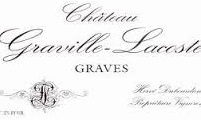 Dry white wines from Bordeaux, typically a blend of Sauvignon Blanc and Semillon, are under appreciated and, as a result, underpriced. In this Graves, a predominance of Semillon lends a creamy texture that is complemented and offset perfectly by the pleasantly pungency of Sauvignon Blanc. Refined enough for an elaborate roast of veal, it’s also sufficiently bright to cut through spicy sushi.
Dry white wines from Bordeaux, typically a blend of Sauvignon Blanc and Semillon, are under appreciated and, as a result, underpriced. In this Graves, a predominance of Semillon lends a creamy texture that is complemented and offset perfectly by the pleasantly pungency of Sauvignon Blanc. Refined enough for an elaborate roast of veal, it’s also sufficiently bright to cut through spicy sushi.
90 Michael Apstein Jul 2, 2013
Château de Rochemorin, Pessac-Léognan (Bordeaux, France) Blanc 2002 ($22, Classic Wine Imports; WJ Deutsch & Sons): The 2002 Château de Rochemorin, an André Lurton property, delivers broad, rich, smoky flavors from its blend of Sauvignon Blanc and Sémillon. Judicious aging in oak barrels adds complexity without dominating. The bright finish holds it all together. 89 Michael Apstein Sep 26, 2006
